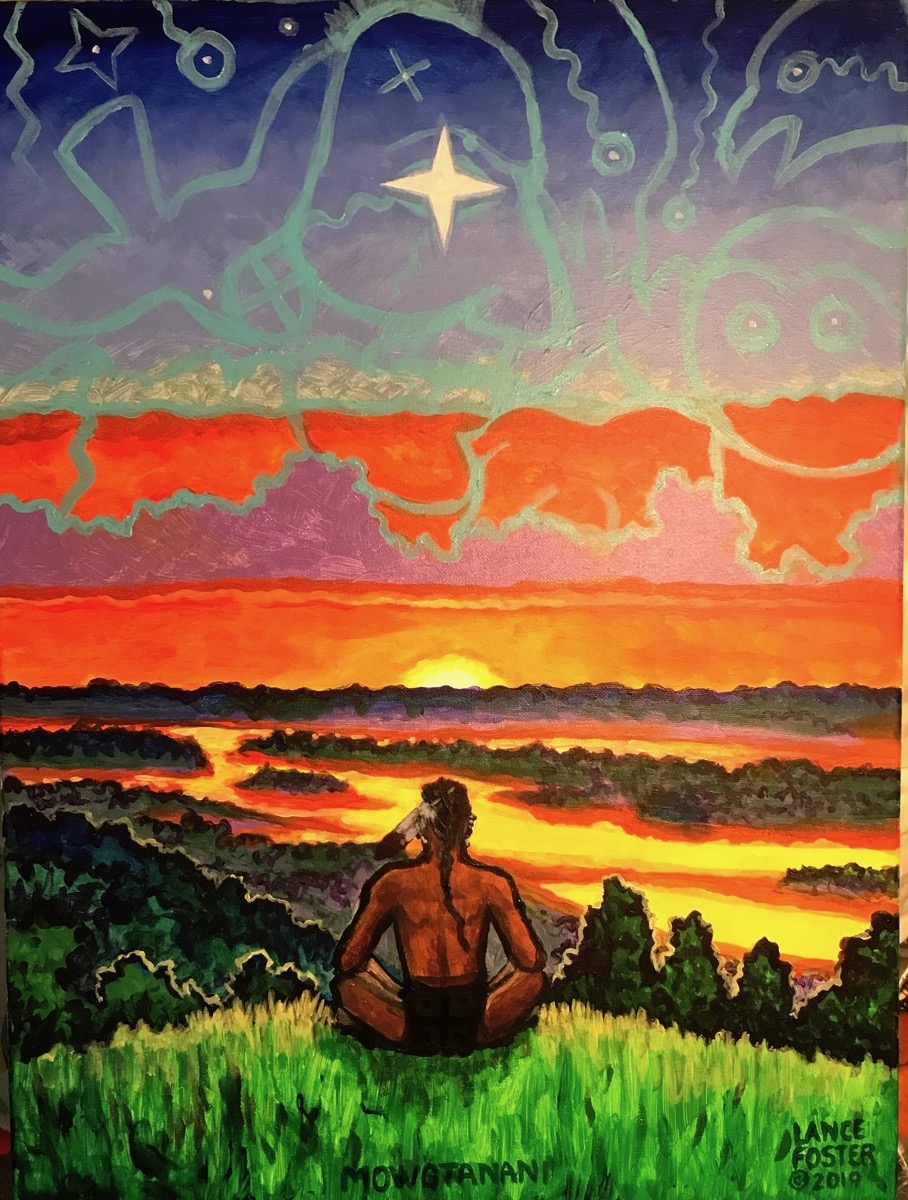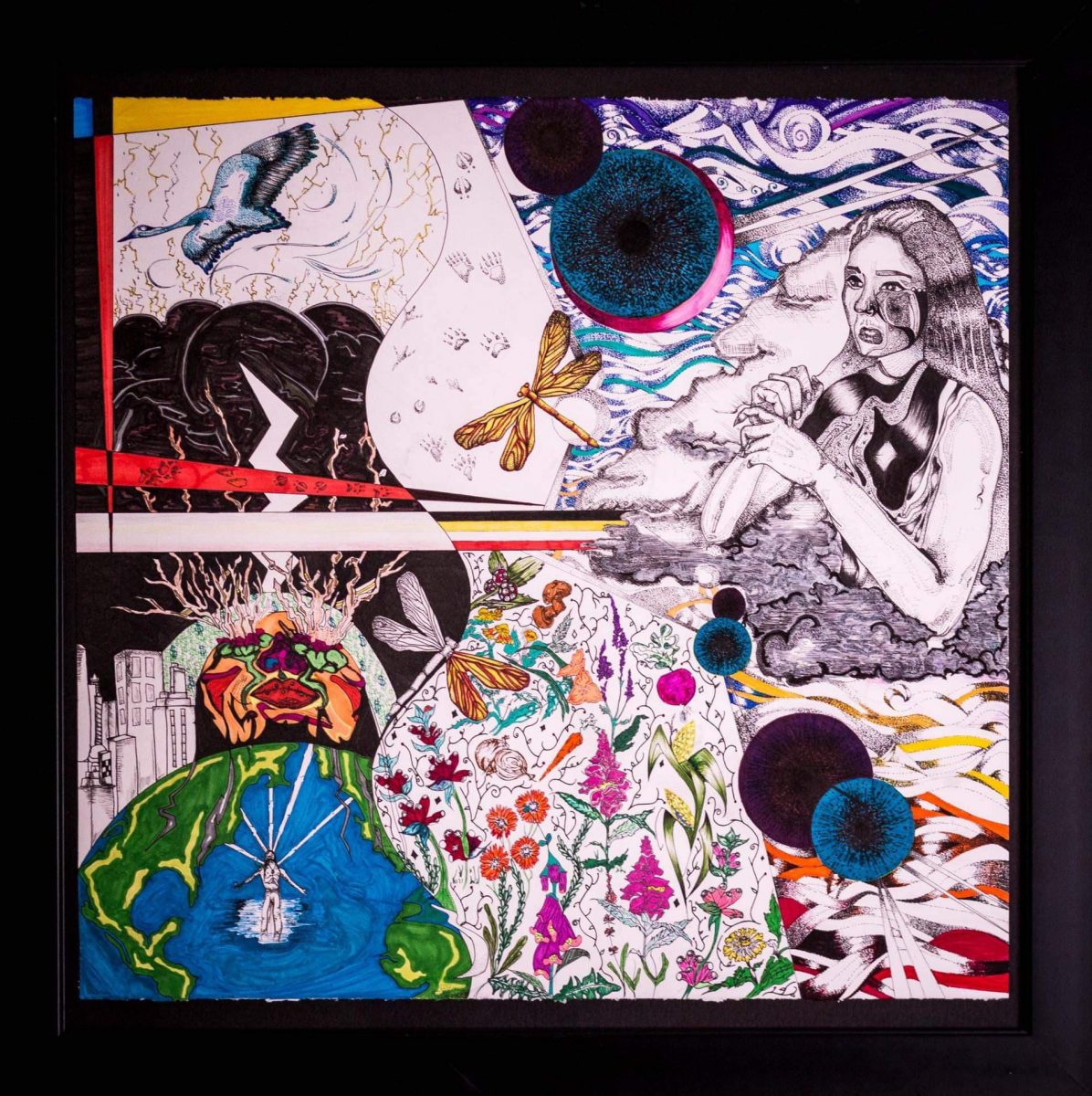Art Inspires Nature Inspires Art
By Brianne Sanchez | Special to INHF on March 13, 2020 in Blog
There is a sacred space in Iowa where — for more than 2,000 years — people have come to contemplate the confluence of river, sky, woodlands and vistas along the limestone bluffs. Here in the Driftless Region, perched at Fire Point overlook, it is easy to imagine the Mississippi River Valley as it once appeared to the ancestors of the many tribal nations who still visit this site in ceremony.
“What human doesn’t walk up to the edge and catch their breath because of the beauty of it?” said Jessica Pope, chief of interpretation and resource education at Effigy Mounds National Monument.
Creating has always been a way of honoring this place. The Effigy Moundbuilders’ conical, bear and bird-shaped mounds have survived millennia, inspiring generations.
A recent art exhibition installed at the Monument’s visitor center — “Reimagining Iowa: 5 Ioway Artists” — has contributed to renewed conversation about the role tribal voices play in telling the stories about the cultural significance of the land, and the relationship between people and natural spaces.

Those who stopped by the visitor center this past fall had the opportunity to encounter Fire Point by brushstroke. In his painting, “Mowotanani,” Lance M. Foster (Irogre) depicts a man — an ancestor — experiencing this incredible vista at sunrise. The sky is a blaze of orange, with symbols of life-sustaining spirits tattooed above the cloud line.
“The good thing about art is that it can inspire and help people think about things differently without talking down to them,” said Foster, who serves as tribal historic preservation officer for the Ioway, and has a background in anthropology and landscape architecture.
Foster’s artist statement that accompanies “Mowotanani” speaks to his ancestors’, and his own, ties to this place, which remains a space of reflection, grounding and a source of spiritual power for tribal nations that extends through generations.
Some people see unchanged land and call it “wild” or “wilderness.” There is no word for “wild” in our native language, but there is a word in our tribal language for the land the way it was originally made by the Creator: Mowotanani. It is the land functioning as it was supposed to function. People trusted the land because they were part of it and it was part of them, and the seasons followed a pattern, as did life. It was reliable and thus trustworthy.
“It’s really exciting; I hope it’s the beginning of many cultural exchanges,” Pope said. “Ultimately, the vision for this visitor center is to turn it into a cultural center. To create space for tribal members to share their culture and their story.”
The artwork was commissioned as part of a Community Art Gathering Grant from the BeWildReWild Fund, which is administered by Iowa Natural Heritage Foundation (INHF). Conceived through a gift from Roger “Ross” Gipple, an entrepreneur, landowner and longtime INHF supporter, the fund supports the artistic exploration of three questions core to the BeWildReWild movement:
- What do you/we mean by wild?
- What changes are needed for us to live within the bounds of sustainability?
- How can we create a wilder, more beautiful, more biologically diverse, and a more enduring Mississippi River Watershed?
Gipple’s own pondering of these questions goes back to 2004 when he established the Agrestal Fund at INHF, which encouraged statewide conversations and art projects around biodiversity in the cornbelt. The BeWildReWild Fund builds upon those relationships and ideas and involves a new generation.
“I think I would say the main theme we’re trying to honor is trusting wildness,” said Gipple, who espouses the deep ecology belief that all life has value, separate from its usefulness to humans. For him, the key to rewilding requires humans to overcome innate fears of surrendering control and of never having enough.
“A lot of what we’re doing, we’re doing from fear,” Gipple said. “If we can get over these fears, we can create a more enduring Mississippi River Watershed.”
Gipple is a man of conviction who is comfortable with his own contradictions. He has made his living through agriculture- related businesses. Proceeds from some of his conventionally farmed properties fund the BeWildReWild project. Gipple is leveraging those profits to invite more people to join in the rewilding cause.
For a man who spent his life in sales, he sees art as a way to garner attention for the wildness his movement believes is good and true, viewing both nature and art as “local, authentic and free” expressions.
“Roger is a true philosopher and has a really dedicated vision,” said Abby Hade Terpstra, INHF donor relations director.
Together, the two navigated the details of a partnership that could celebrate the intersection of art and nature. Shared goals of strengthening river corridors and protecting contiguous pieces of land that allow for water and wildlife to move created a language of commonality between the independent grassroots group and INHF.
“I’m really happy with where we ended up,” Terpstra said. “INHF is a place of steadiness that works across a wide range of conservation ideas. Roger’s BeWildReWild philosophy has its place on that spectrum, and the BeWildReWild fund helps explore and encourage important conversations.”
For Missouri-based artist Sydney Pursel, whose seed bomb dispenser artwork was featured in the Ioway exhibition, exposure to the BeWildReWild concepts and engagement with the group’s Facebook page inspired her to consider her own relationship to the land in new ways. “I am really passionate about making art that’s proactive in some way,” she said. “I think that it’s valid for art to bring up social issues, but I’m trying to go a step further in my art by finding solutions to create change.”
Although Pursel’s heritage always factors into her work, being part of an all-Ioway exhibition for the first time — alongside her father, Phillip — had an added benefit of strengthening tribal ties.
“It’s just been a really fun experience,” she said. “The interest that it has provoked has been really surprising. I knew we were going to put up some art in a visitor center at Effigy Mounds, but I’ve been surprised by the reach that it has had.”
In rewilding, the impact doesn’t end with individual impressions, or even engagement in ecological ideas. It all comes back to the land.
Nitin Gadia’s BeWildReWild funded project – a large digital map of the entire Mississippi River Watershed – allows people to see what [rewilding] would look like. By turning layers on and off the user can see the natural land and wildlife corridors now, and then the ideal future if rewilding is accomplished.
“We’re mapping how the world would look if it were saved,” he said.